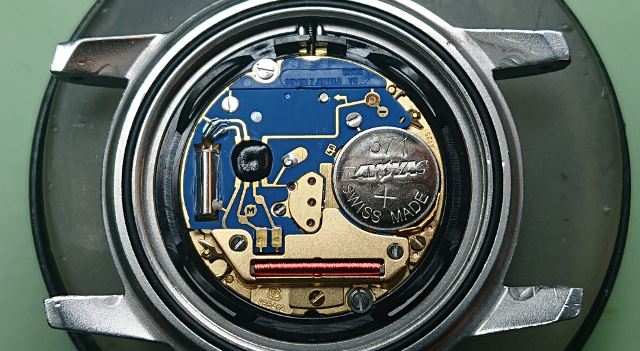Quartz watches – watches usually powered by batteries – are very popular and we regularly see a huge variety of quartz models in our workshop. But how does a quartz watch actually work? In this blog post we’ll do our best to describe just how a quartz watch is able to transfer power from a battery through to the hands to indicate the time.
A battery (or strictly speaking, a cell), supplies the electricity needed to power a quartz watch. Electrical energy is produced by a chemical reaction between the two battery terminals and an electrolyte.
In order for a watch to work and accurately tell the time, it needs to use a ‘resonant oscillator’ – that is an oscillator which has a natural frequency of vibration. In mechanical watches or clocks this could be a pendulum (a weight acting against gravity), or a balance (a weight acting against a spring). Quartz watches use – as the name would suggest – a tiny piece of quartz. This piece of quartz is shaped like a tuning fork and when this is made to vibrate, it maintains a constant frequency.

Thanks to the piezo-electric effect, applying a voltage to the quartz crystal will set it vibrating. This vibrating quartz crystal acts as the balance would in a mechanical watch and is responsible for the incredible accuracy of quartz watches. Indeed, a standard mechanical watch balance may vibrate at 2.5Hz, whereas a quartz crystal vibrates at a staggering 32,768Hz! This accounts, at least somewhat, for the incredible accuracy of the quartz watch.
In order for a quartz watch with a second hand to tell the time, we need an electrical pulse once per second. The watch integrated circuit is responsible for dividing down this figure to achieve the required single pulse per second.
This regular pulse per second is now used to drive a motor. The motor consists of a rotor, a stator and a coil. The motor is a permanent magnet and it is made to rotate through 180 degrees for each pulse received. Thanks to some clever design, this rotor will always turn in the same direction. That means if we attach a pinion to the top of the rotor we are able to drive a series of wheels from it.
From the rotor, the intermediate wheel is driven, the pinion of the intermediate wheel drives the second wheel (and on the pinion of this the second hand is attached). The second wheel pinion drives the third wheel. The third wheel arbor extends through to the dial side of the watch movement, and this is responsible for turning the driving wheel. The driving wheel leads to the rotation of the minute and hour hands.
As you can see from the brief description above, there’s actually quite a lot to a quartz watch. Do you have a quartz watch in need of repair? We are able to repair and restore almost any model and type of watch, including quartz. With our fully insured freepost watch repairs service we offer repairs to clients all around the UK. As holders of a Feefo Platinum Trusted Service Award and business partners of the British Horological Institute you can be confident in the service we provide.
Please Contact Us for further information regarding any requirement you may have.
Yours sincerely
David Clark DGA PJDip PJGemDip CertGA
Managing Director
W.E. Clark & Son Limited
